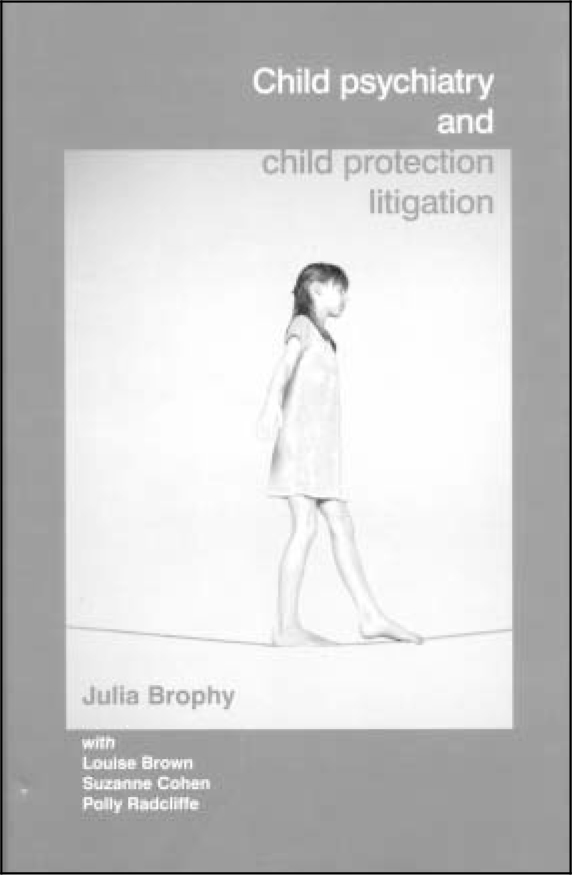
This book is calling for a revolution in the way public child care law is supported by child psychiatry. Children caught up in care proceedings or under secure orders, or those with severe educational difficulties have a much greater need of child and adolescent mental health services (CAMHS) and yet are not usually seen as a priority. Many CAMHS are reluctant to take on this work when the family, child or young person is presented as a piece of ‘court work’. Ideally, these troubled families and young people would already be known by their local service and, if court intervention were needed, it would be part of the CAMHS work and any advised interventions could be then carried out locally. Of course, there would always be some complex cases that needed an outside expert opinion or where a second opinion was more appropriate. However, the bulk of this work, as with looked after children, should be part of a local CAMHS.
Sadly, this is far from the reality, and Julia Brophy has set out to explore and document the current position. In this book, she interviews child and adolescent psychiatrists; six ‘national’ experts and 11 local consultants. The volume begins with a review of the Children Act 1989 and the context within which work in a public law court is undertaken. She explores how the Act has caused a considerable growth in the demand for child and adolescent mental health input into the decision-making process, both to determine significant harm, particularly in relation to emotional abuse, and also to assist the court in considering future options for the child, young person and family.
This is followed by a discussion of the NHS structure and the contractual arrangements that have led to the bulk of this court work being seen as category 2 work, i.e. outside the usual NHS contract. Brophy considers how this system has resulted in waiting lists and the random uptake of cases when consultants who are willing to do the work have time to do so. Is this a good way to provide vulnerable families with a service? She goes on to discuss the problems that arise when an expert opinion recommends an intervention the local service cannot or will not provide.
The implications for this public law work are considered, given the government proposal for the new consultant contract. If many experts are approaching retirement age and junior consultants cannot undertake private work for 7 years, what will happen? Many consultants are reluctant to undertake the court work and junior consultants will not be allowed to do so. Will the service depend on a bank of retired consultants? Is this desirable? Of course, some of the work can be managed in this way but it is not in the best interest of the children and families to have them mainly excluded from their CAMHS, and training specialist registrars will be more problematic.
The chapter dealing with the contributions child psychiatrists bring to court work is rich in quotations which show the diversity and commitment of colleagues and also demonstrate some arrogance. It is hard to pin down what we contribute but it is clear that we do and what we put in our reports is given considerable weight; particularly when considering risk, future placement and intervention. The book debates the use of a single expert, jointly instructed, or several experts who meet and discuss as a multi-disciplinary team.
The clinical and legal agendas are discussed, how the two discourses coincide or diverge and the implications of this for the children and families. There is an interesting debate on whether the lawyers are changing clinical practice or the psychiatrists are educating the lawyers and the courts. For example, the ‘facts’ in a court report that lead to a diagnosis of emotional abuse. Is there a need for hard evidence or will soft evidence and clinical judgement be more useful in conveying the issues that need to be decided? This leads to a revisitation of the value, or not, of the adversarial approval. All those interviewed valued the fact that their opinion was being discussed, debated and cross-examined, but then these consultants are doing court work and those unwilling to be questioned are not.
The book ends with the author's recognition that the family justice system is now a multi-professional, multi-agency domain, and that changes in policy and practice evolve through a range of forums when issues are discussed, training initiatives are developed and future outcomes are monitored.
This is an interesting book, easy to read and an important text for child and adolescent psychiatrists, those in family court work, social workers, those involved in the Children and Families Court Advisory Service (CAFCASS), lawyers and CAMHS professionals. Julia Brophy highlights problems and concerns that need to be addressed if these children, young people and families are to have access to the service, support and interventions they need.



eLetters
No eLetters have been published for this article.